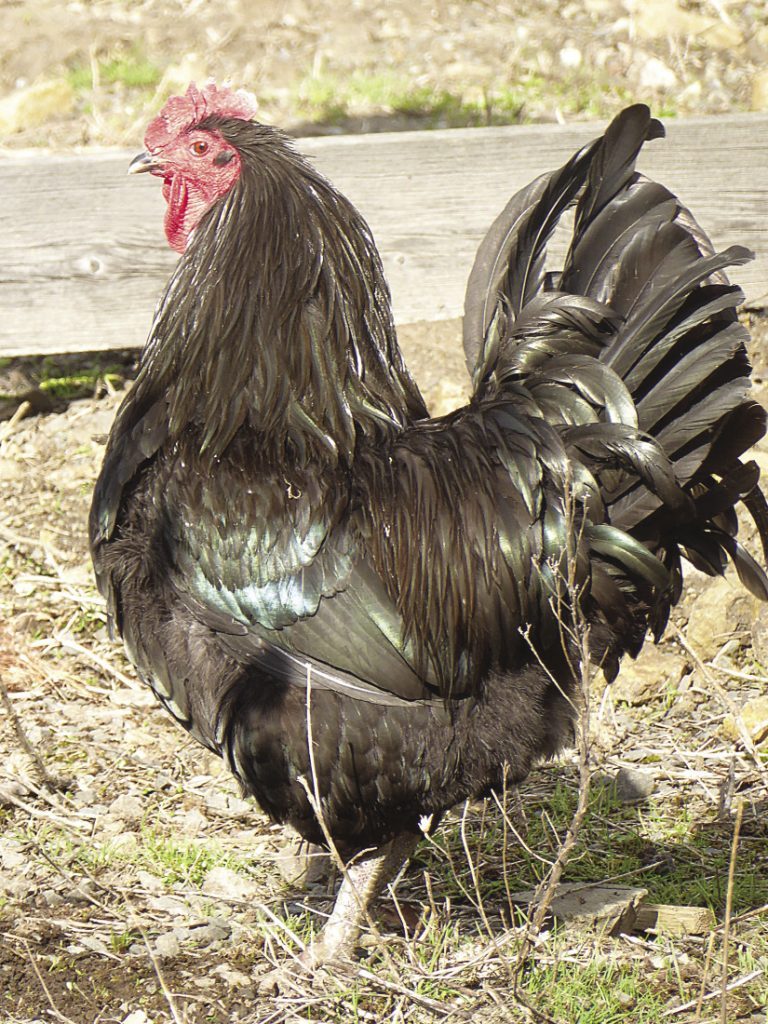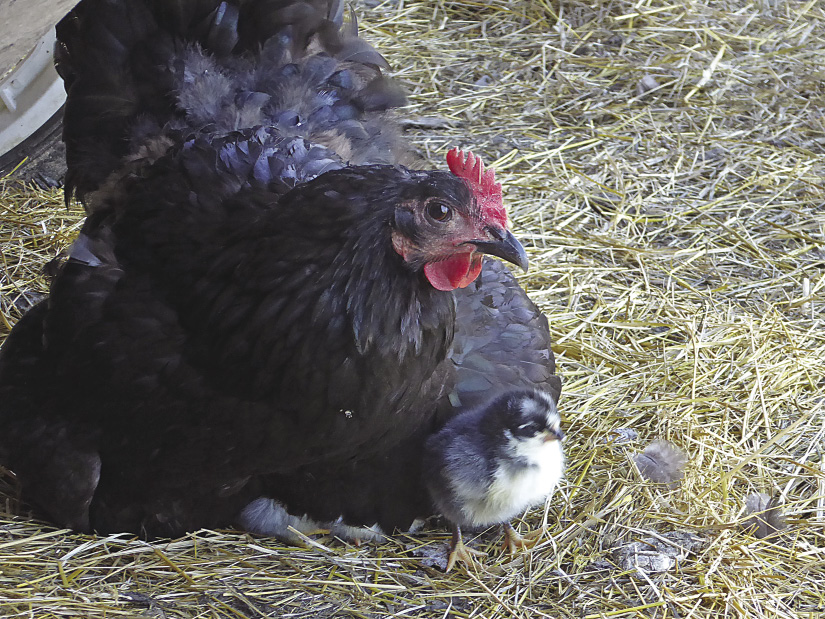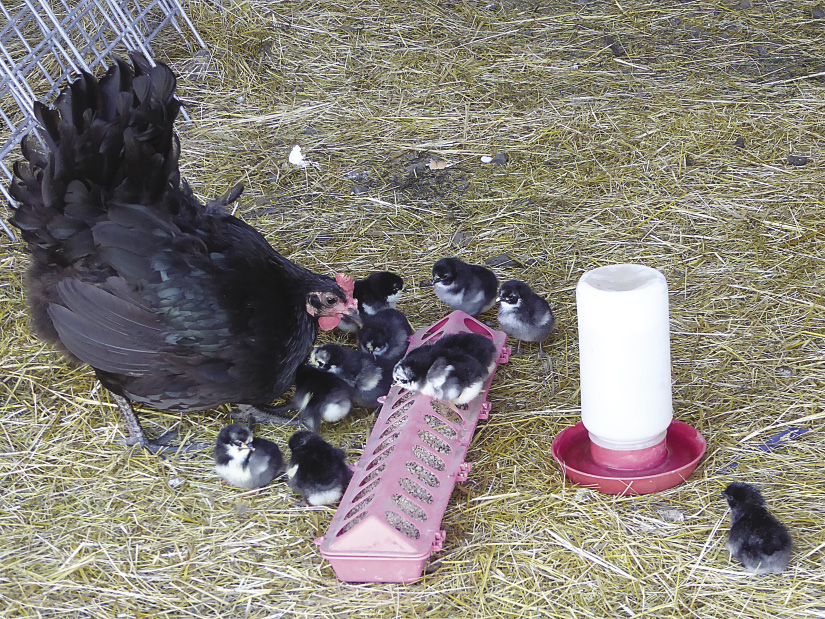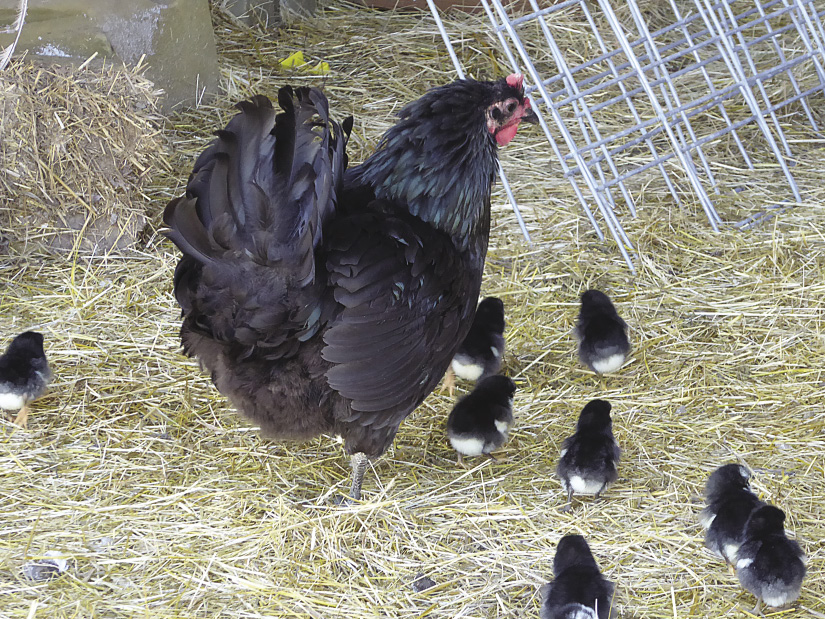By Patrice Lewis
We’ve raised chickens for years, both for eggs and meat. Getting eggs from chickens is easy. Getting meat … well, not so much. No matter how many times you hear about various breeds being touted as “dual purpose” — good for eggs and meat — the meat part is likely to be disappointing. The bird that goes in your freezer is likely to be about the size of a skinny “rubber chicken” rather than the fat roasters you see on the rotisserie at Costco.
So, like most rural Americans, we turned to Cornish Crosses for our meat birds. We’ve tried them on and off over the years, but we stopped raising them for two reasons.

Reason one: Cornish Crosses, as meat birds, fulfill their function superbly. They gain weight with a speed and seriousness that is awesome to behold. Within nine or ten weeks max, they’re ready for the freezer.
Except here’s the thing: If you don’t put them in the freezer by nine or ten weeks, their bodies start to break down. Their organs fail. Their joints give out. They can’t walk. They expire at the drop of a hat. It’s horrifically sad. I call them weird freaky mutant chickens.
Reason two: We can’t breed Cornish Crosses ourselves. We’re trying to make our homestead more self-sustaining, not less. If we have to purchase chicks from the feed store every time we want to raise meat birds, we’re taking a step backward, not forward. We looked into what it takes to breed Cornish Crosses, but it turns out they have a rather complicated tangle of genetics that precludes the home breeder from duplicating the exact lineage without a lot of dedicated work.

A couple of years ago, after butchering our last batch of Cornish Crosses, we decided “no more.” Never again did we want weird freaky mutant chickens on our farm.
So the search was on for replacement birds. What breed would dress out large enough for a meal, yet stay healthy enough to grow to adulthood? What breed could equal the fat and delicious Cornish Crosses as a meat bird, but which we could raise ourselves? That’s when we found Jersey Giants.
Purpose one: The original meat bird
As the name implies, this breed was originally developed in New Jersey in the late 1800s by two brothers, John and Thomas Black. They were the original “commercial” meat chicken bred to replace the turkey, which was the primary table bird at the time (doubtless because other chicken breeds were too scrawny to provide a substantial meal, which we’ve found is true even now). They are considered the largest purebred chicken breed.
Jersey Giants come in three colors: Black, white, and “blue” (a bluish slate-gray). Black is the dominant gene, so white birds come from breeding two recessive whites. Blue giants come from an incomplete dominant gene. There is also a “splash” variety, in which the bird has two copies of the blue gene. Splash birds are a paler slate color, or have whitish streaks. They are not recognized as an “official” variety and therefore can’t be used as show birds. On average, the blacks tend to outweigh the whites by about a pound.
Today, the slower-growing Jersey Giant has been entirely supplanted by the fast-growing Cornish Cross in the meat industry, a fully understandable decision in terms of profitability. However for the self-sustaining homestead, where “fast” isn’t as strong a consideration as “humane” and “reproducible,” the Jersey Giant has proven to be a superb choice for us.

In June 2015, we received 10 pullets and five straight-run (unsexed) chicks from Murray McMurray Hatchery, all of which arrived in excellent health. Of the straight-run chicks, three were roosters (one of which got picked off by a coyote).
We haven’t butchered our two roosters since they are our flock sires. We have several young second-generation roosters who have not yet reached butchering weight (as of this writing), however our current mature boys weigh in at about 12 pounds each. Using the average ratio of live weight to dressed weight (dressed chickens are about 75 percent of live weight), we can anticipate about a nine-pound bird in the freezer at butchering time. Since most chickens are processed at about 4.5 pounds live weight, we expect a satisfactorily hefty roaster.
Jersey Giants have a reputation for growing “slower” than other breeds of chickens. In fact, they grow at the same pace; it’s just that they have farther to go to reach their full size. They tend to achieve their large frame first, then put on weight later. Since roosters take about nine months to achieve maximum weight, they are considered to have a poor feed/weight conversion. Again, that’s a factor for commercial enterprises, but not as important on a homestead.
We’ve found the hens to be not much larger in size than Black Australorps or Rhode Island Reds, so our meat efforts have been concentrated on the roosters. We keep the two mature roosters with the hens for both fertilization and protection, and they are all free-range. Our young roosters destined for the freezer are kept in a separate pen with a large enclosed run.

Allowing birds to be free-range greatly reduces dependency on commercial feed, particularly during warmer months. Our birds make good use of our extensive barn-waste compost pile. (We’re also working on raising enough wheat and corn for chicken feed in addition to human consumption, but that’s another article.)
Purpose two: Eggs galore
With the Jersey Giant emphasis on meat, we had no particular expectations the hens would be anything more than adequate egg layers. As it turns out, the hens are superb layers. Of course they don’t equal breeds which are dedicated for eggs, such as Leghorns, but we have been more than satisfied by the amount of henfruit we’ve received.
The eggs are on the medium-to-large side, but not especially huge. The eggs are brown, varying from dark brown to light cream, and sometimes show faint speckles. Hens start laying small “pullet” eggs at about the same time as other breeds, at five months of age or so.
Purpose three: Sustainability
I’ve claimed Jersey Giants as excellent triple-purpose birds. They’re excellent for both eggs and meat, so what’s the third benefit? Broodiness. I have never, and I mean never, seen a breed so inclined to go broody.
As anyone who has ever raised chickens knows, broodiness has been bred out of many breeds. Several types of chickens are known to be more inclined toward broodiness (notably bantams), and sometimes a particular hen of any breed goes broody, but in our experience, only the Jersey Giants have been remarkably consistent in their instinct.
During our first year with Jersey Giants, I had hens going broody at all times and in all places. I keep about a dozen wooden “nest eggs” to encourage hens to lay in convenient places, but I’ve also found these false eggs to be useful when hens go broody in the wrong season. One dedicated hen stayed on a batch of wooden eggs through bitterly cold December weather (I picked her up and put her in the coop each night, and each morning she would faithfully re-settle herself back on the fake eggs, located seven feet up on top some hay bales).
Some people say Jersey Giants are so big the broody hens tend to break their own eggs. I haven’t had that issue, namely because our girls are not that large.
Last summer we allowed two hens to hatch their broods. After the first lady hatched a “baker’s dozen” of chicks, a neighbor happened to stop by. When we showed him the babies peeping around their mother, he was delighted. “Aha!” he exclaimed. “Sustainability!” Broodiness has been bred out of so many chicken breeds that finding a hen who will hatch her own eggs is increasingly rare.
Pluses and minuses
Of course, nothing is perfect. There will always be something dissatisfying with any breed of chicken.
The biggest flaws of Jersey Giants are:
• Slower maturity. We aren’t overly concerned about this.
• Dark feathers, which can leave dark pinfeathers on a plucked bird during butchering. Raising white Jersey Giants will reduce this detriment.
• Roosters, due to their large size, can be a bit tough on the hens. We had a few bald ladies with bare backs until the boys got into their stride. We have not found the roosters to be aggressive toward people.
• They require proportionately more feed, which can be offset by allowing the chickens to be free range.
The biggest benefits of Jersey Giants are:
• A table bird of suitable size for a family
• Cold-hardy (we live in the north Idaho panhandle)
• Sustainability, since the hens go broody easily
• Not prone to health issues
• Hens are excellent layers
• They are a heritage breed
Heritage breed chickens have several benefits: they reproduce and genetically maintain their qualities through natural mating; they have a long productive outdoor lifespan, and their slow growth rate means their skeletal structure, organs, and muscle mass develop healthily.
At this point, we consider the benefits of Jersey Giants as outweighing the detriments. The ability to sustain a flock was high on our list. Add to it the large size and the egg-laying proclivities, and the result is an overall excellent choice for a homestead chicken.

Well written and excellent! I raise and breed many types of poultry for self use and for my feed store. I only carry breeds with kind dispositions, and the Giants are one of our favorites.
Jersey giants are awsome and only second to Brahma’s.out of all the large breeds around I found that the Brahma’s are even more docile “on average” and ALL are good setters.like you said.I’ve never seen anything like either one of these two large breeds when it comes to setting.the biggest plus to brahmas is “on average”the roosters are tamer and the colors of Brahma’s is much much better.same meat and egg size.same amount of eggs per year.both lay well in the winter even here in Alaska.both like the cold.and both are large butcher birds.just brahmas “on average” lol are kinder roosters and way way way better to look at with way way way more color variations.did you know the largest rooster ever was a Brahma and not a jersey.even though they put the jersey over the Brahma “on average”.well I’m not sure you wanted to hear any of this but I didn’t even here you mention the elephant in the room which is the Brahma’s.equal to on all three counts just better looking.and “on average” nicer roosters and better setters.but JG’s are great.
Alguien me puede decir a los cuantos meses o semanas se pone en el congelador como ustedes disen un JG y
Grasias por por la informasion
I am trying to get a jersey giant rooster.
I’m curious about the taste and quality of the meat? Would you say it’s better tasting than any other “dual purpose” breed? I currently have Marans, Smokey pearl and easter eggers. The marans we intend to breed and raise up for meat. Would the Jersey Giants be superior in taste, not just size?
I have 6 , 5 month old Jersey gaint hens, who are very small. We bought the chicks as they arrived at rural king, and soon discovered they were heavily infested with lice. They were treated for that. They no longer have that problem. But they just look like crows next to our wyandotte, who are only a few weeks older than they are. They get plenty of feed, and are well taken care of. I just wondered if anyone can tell me if they might have an internal parasite problem?
My eight month old blue Jersey Giant pullet is about the same weight as my massive 2-year-old blue Cochin rooster. She’s also taller than him. She is heavier than my Brahma hens and my chunky old lady barred rock by a fair bit.
My Jersey Giants are large. They ARE larger than Rhodes or Austrolorpes. If you are not achieving the size, you may not have a full Jersey Giant. I have indeed had a broody hen break two of the four eggs she was sitting on. This year, June 2021, she successfully hatched out her clutch. No broken eggs. Broody is definitely a trait. I have an incubator though, so this is less of a concern. I raise blues and blacks and we are very happy with this breed. I like the idea of ‘triple purpose’ birds. Re: cold hardy, yes, they are, but here in Canada you really need to watch the frostbite of the ginormous comb and wattles on the roosters. Vaseline or bag balm is critical to have on hand.
Hi from across the ocean (Austria).
Thanks for this interesting article, there’s not so much to be found around JG in German, so I switched over to english ?
I bought 12 eggs from a local JG breeder and made 9 chicks to hatch. They are healthy and growing ?.
I hope for more hens than roosters, as our neighbors won’t tolerante the noise.
Looking forward to warmer weather, so the chicks can move outside ?.
Kind regards, Claudia
Thanks for the information. Very good information shared. Will get a few of these in the fall so my daughter can sale at fair next year.
I got the impression that you didn’t have to do anything with the chicks once they hatched. Is that true? We live in a city and don’t want to have to get into incubating and raising the chicks in our house. Thanks for the Excellent article and I hope that your ladies (and gentlemen) are doing great! God bless from TN.
A friend and I got our JGs from Meyer Hatchery, in the Brown Egg Layer Assortment. They are sweet, mellow and beautiful. Nice that I won’t need to buy an Incubator!
I am a first time chicken owner. I have 5 white leghorns, 3 Rhode island reds, and three buff orphingtons. I really want jersey giants
I have a Black Jersey rooster. When a friend first gave to me I thought it was a young hen but eventually its back feathers started struting out and i knew it was a rooster. I am encouraged that they can grow big. I intend to find 2-3 young hens and fence a yard for them to roost and lay eggs too.
I wish to buy black jersey gaint hens.Where from can i buy these hens.I am from Pakistan.would you please help me in this regard.
We are also in the north idaho panhandle!!! Getting our jerseys today
Interested in raising
I have 12 JG idk the sex yet as they are just chicks but at what age do you process your roosters so the meat is good? I’ve heard that roosters meat is very stringy? And not very good so wanting to know at what i should be butchering the roos
I bought 16 giants from a lady named Maria. She breeds just giants and some turkeys. They all arrived healthy and are now six weeks old. I couldn’t be happier with how they are doing.
I am starting out with 40 chicks 10 of those are hens thank you so much for this article it was very helpful.
Looking for jersey gaint chicks set
Feed them the right commercial feed.
Hens will lay more and have bigger size and better feather cover, so you won’t have problems when your roosters are mating.
Don’t use whole corn and wheat, but whole oats. Oats has more protein and is not contained in the commercial feed.
I have 4 Black Jersey Giants now, have had them since last year and LOVE them for all of this articles reasons.
Great bird!
My name is Louis, showing interest in raising chickens . For now, I am living in Hempstead New York, and also would be interested in getting more information about the Jersey Giant chicken and will probably try to contact you for more details since, that’s going to be my habit with my retirement coming soon.
Your article just settled my debate in Cornish or Jersey. My question is do you plan to rotate out roosters when yours are a few years older? The ones you keep to fertilize.
I have a bronze laced black giant hen I bought is that good for reproducing I was advised not to what do you think
thanks for helpful article..just bought 4 Jersey chicks, not knowing what I was getting..am pleased that will fit a niche on my small farm..
I couldn’t be more pleased they were very good with imprinting and they’re starting to get their flight feathers There are only two weeks old I understand I have a long way to go but I’m looking forward to every step
I’m starting out with eight checks a black jersey giants and I’ve been more pleased with the comments I’m not raising them for meat I’m raising them for eggs and productivity